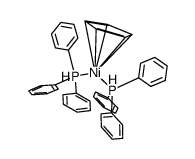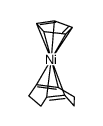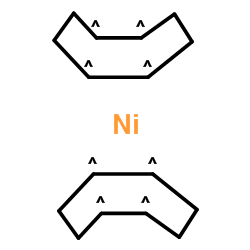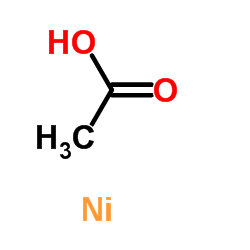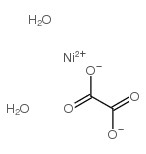1271-28-9
| 中文名 | 双(环戊二烯)镍 |
|---|---|
| 英文名 | nickelocene |
| 中文别名 |
双(氯茂基)镍
二茂镍 |
| 英文别名 |
Nickel(2+) di(2,4-cyclopentadienide)
NICKELOCENE nickel(2+) dicyclopenta-2,4-dienide Bis(cyclopentadienyl)nickel EINECS 215-039-0 MFCD00001441 |
| 熔点 | 171-173 °C(lit.) |
|---|---|
| 分子式 | C10H10Ni |
| 分子量 | 188.880 |
| 精确质量 | 188.013596 |
| LogP | 2.04300 |
| 外观性状 | 固体;Dark green to Dark blue to Black powder to crystal |
| 储存条件 | 保持贮藏器密封、储存在阴凉、干燥的地方,确保工作间有良好的通风或排气装置 。 |
| 稳定性 | 如果遵照规格使用和储存则不会分解,未有已知危险反应,避免氧化物 |
| 水溶解性 | 水溶性:不溶;极微溶:甲苯 |
| 分子结构 | 1、摩尔折射率:无可用的 2、摩尔体积(cm3/mol):无可用的 3、等张比容(90.2K):无可用的 4、表面张力(dyne/cm):无可用的 5、介电常数:无可用的 6、极化率(10-24cm3):无可用的 7、单一同位素质量:188.013599 Da 8、标称质量:188 Da 9、平均质量:188.8798 Da |
| 计算化学 | 1、 氢键供体数量:0 2、 氢键受体数量:2 3、 可旋转化学键数量:0 4、 拓扑分子极性表面积(TPSA):0 5、 重原子数量:11 6、 表面电荷:0 7、 复杂度:11.6 8、 同位素原子数量:0 9、 确定原子立构中心数量:0 10、 不确定原子立构中心数量:0 11、 确定化学键立构中心数量:0 12、 不确定化学键立构中心数量:0 13、 共价键单元数量:3 |
| 更多 | 1. 性状:深绿色结晶。为高活性化合物,在空气中很快分解。在真空中升华。 2. 密度(g/mL,25/4℃):未确定 3. 相对蒸汽密度(g/mL,空气=1):未确定 4. 熔点(ºC):171~173 5. 沸点(ºC,常压):未确定 6. 沸点(ºC,5.2kPa):未确定 7. 折射率:未确定 8. 闪点(ºC): 未确定 9. 比旋光度(º):未确定 10.自燃点或引燃温度(ºC):未确定 11.蒸气压(kPa,25ºC):未确定 12.饱和蒸气压(kPa,60ºC):未确定 13.燃烧热(KJ/mol):未确定 14.临界温度(ºC):未确定 15.临界压力(KPa):未确定 16.油水(辛醇/水)分配系数的对数值:未确定 17.爆炸上限(%,V/V):未确定 18.爆炸下限(%,V/V):未确定 19.溶解性:溶于多数有机溶剂,不溶于水。在丙酮、乙醇和乙醚中分解。 |
Synonym:Nickelocene; Di-Pi-Cyclopentadienylnickel Section 2 - COMPOSITION, INFORMATION ON INGREDIENTS
Risk Phrases: 20/21/22 42/43 Section 3 - HAZARDS IDENTIFICATION EMERGENCY OVERVIEW
Harmful by inhalation, in contact with skin and if swallowed. May cause sensitization by inhalation and skin contact.Air sensitive.The toxicological properties of this material have not been fully investigated. Potential Health Effects Eye: May cause eye irritation. Skin: May cause skin irritation. May cause skin sensitization, an allergic reaction, which becomes evident upon re-exposure to this material. Causes "nickel itch" which is a dermatitis resulting from sensitization to nickel, which is characterized by skin eruptions, followed by discrete ulcers that may discharge and become crusted, or by eczema. Ingestion: Harmful if swallowed. May cause irritation of the digestive tract. Inhalation: May cause respiratory tract irritation. The toxicological properties of this substance have not been fully investigated. May cause lung damage. In rare instances, exposure may cause sensitization, resulting in inflammation of the mucous membranes and in eczematous eruptions. Chronic: Symptoms of overexposure to nickel can cause sensitization, dermatitis, allergic asthma and pneumonitis. Section 4 - FIRST AID MEASURES Eyes: Flush eyes with plenty of water for at least 15 minutes, occasionally lifting the upper and lower eyelids. Get medical aid. Skin: Get medical aid. Flush skin with plenty of water for at least 15 minutes while removing contaminated clothing and shoes. Wash clothing before reuse. Ingestion: Get medical aid. Do NOT induce vomiting. If conscious and alert, rinse mouth and drink 2-4 cupfuls of milk or water. Wash mouth out with water. Inhalation: Remove from exposure and move to fresh air immediately. If not breathing, give artificial respiration. If breathing is difficult, give oxygen. Get medical aid. Do NOT use mouth-to-mouth resuscitation. If breathing has ceased apply artificial respiration using oxygen and a suitable mechanical device such as a bag and a mask. Notes to Physician: Section 5 - FIRE FIGHTING MEASURES General Information: As in any fire, wear a self-contained breathing apparatus in pressure-demand, MSHA/NIOSH (approved or equivalent), and full protective gear. During a fire, irritating and highly toxic gases may be generated by thermal decomposition or combustion. Use extinguishing media appropriate to the surrounding fire. Substance is noncombustible. Extinguishing Media: Substance is noncombustible; use agent most appropriate to extinguish surrounding fire. Use water spray, dry chemical, carbon dioxide, or appropriate foam. Section 6 - ACCIDENTAL RELEASE MEASURES General Information: Use proper personal protective equipment as indicated in Section 8. Spills/Leaks: Vacuum or sweep up material and place into a suitable disposal container. Clean up spills immediately, observing precautions in the Protective Equipment section. Avoid generating dusty conditions. Provide ventilation. Place under an inert atmosphere. Section 7 - HANDLING and STORAGE Handling: Wash thoroughly after handling. Use with adequate ventilation. Minimize dust generation and accumulation. Avoid contact with eyes, skin, and clothing. Keep container tightly closed. Avoid ingestion and inhalation. Handle under an inert atmosphere. Store protected from air. Storage: Keep under a nitrogen blanket. Store in a cool, dry, well-ventilated area away from incompatible substances. Do not expose to air. Store under an inert atmosphere. Section 8 - EXPOSURE CONTROLS, PERSONAL PROTECTION Engineering Controls: Facilities storing or utilizing this material should be equipped with an eyewash facility and a safety shower. Use adequate ventilation to keep airborne concentrations low. Exposure Limits CAS# 1271-28-9: United States OSHA: 1 mg/m3 TWA (as Ni) (listed under Nickel sol compounds). Belgium - TWA: (listed as nickel soluble compounds): 0.1 mg/m3 VL (as Ni) Malaysia: (listed as nickel soluble compounds): 0.1 mg/m3 TWA (inhalable fraction, as Ni) Netherlands: (listed as nickel soluble compounds): 0.1 mg/m3 MAC Ni) Spain: (listed as nickel soluble compounds): 0.1 mg/m3 VLA-ED (as Personal Protective Equipment Eyes: Wear appropriate protective eyeglasses or chemical safety goggles as described by OSHA's eye and face protection regulations in 29 CFR 1910.133 or European Standard EN166. Skin: Wear appropriate protective gloves to prevent skin exposure. Clothing: Wear appropriate protective clothing to prevent skin exposure. Respirators: A respiratory protection program that meets OSHA's 29 CFR 1910.134 and ANSI Z88.2 requirements or European Standard EN 149 must be followed whenever workplace conditions warrant respirator use. Section 9 - PHYSICAL AND CHEMICAL PROPERTIES Physical State: Crystals Color: black - green - orange Odor: none reported pH: Not available. Vapor Pressure: Not available. Viscosity: Not available. Boiling Point: Not available. Freezing/Melting Point: 171 - 173 deg C Autoignition Temperature: Not applicable. Flash Point: Not applicable. Explosion Limits, lower: Not available. Explosion Limits, upper: Not available. Decomposition Temperature: Solubility in water: Insoluble. Specific Gravity/Density: Molecular Formula: C10H10Ni Molecular Weight: 188.76 Section 10 - STABILITY AND REACTIVITY Chemical Stability: Stable at room temperature in closed containers under normal storage and handling conditions. Conditions to Avoid: Incompatible materials, dust generation, exposure to air, excess heat. Incompatibilities with Other Materials: Air, strong oxidizing agents. Hazardous Decomposition Products: Carbon monoxide, irritating and toxic fumes and gases, carbon dioxide, nickel oxide. Hazardous Polymerization: Has not been reported Section 11 - TOXICOLOGICAL INFORMATION RTECS#: CAS# 1271-28-9: QR6500000 LD50/LC50: CAS# 1271-28-9: Oral, mouse: LD50 = 600 mg/kg; Oral, rat: LD50 = 490 mg/kg. Carcinogenicity: Bis(1,5-Cyclopentadienyl)Nickel - California: carcinogen, initial date 10/1/89 NTP: Known carcinogen (listed as Nickel compounds). IARC: Group 1 carcinogen (listed as Nickel compounds). Other: See actual entry in RTECS for complete information. Section 12 - ECOLOGICAL INFORMATION Section 13 - DISPOSAL CONSIDERATIONS Dispose of in a manner consistent with federal, state, and local regulations. Section 14 - TRANSPORT INFORMATION IATA Not regulated as a hazardous material. IMO Not regulated as a hazardous material. RID/ADR Not regulated as a hazardous material. Section 15 - REGULATORY INFORMATION European/International Regulations European Labeling in Accordance with EC Directives Hazard Symbols: XN Risk Phrases: R 20/21/22 Harmful by inhalation, in contact with skin and if swallowed. R 42/43 May cause sensitization by inhalation and skin contact. Safety Phrases: S 22 Do not breathe dust. S 24 Avoid contact with skin. S 28A After contact with skin, wash immediately with plenty of water. S 36/37 Wear suitable protective clothing and gloves. S 37 Wear suitable gloves. S 45 In case of accident or if you feel unwell, seek medical advice immediately (show the label where possible). WGK (Water Danger/Protection) CAS# 1271-28-9: No information available. Canada CAS# 1271-28-9 is listed on Canada's NDSL List. CAS# 1271-28-9 is listed on Canada's Ingredient Disclosure List. US FEDERAL TSCA CAS# 1271-28-9 is listed on the TSCA inventory. SECTION 16 - ADDITIONAL INFORMATION N/A |
|
生态学数据: 对是水稍微有危害的不要让未稀释或大量的产品接触地下水、水道或者污水系统,若无政府许可,勿将材料排入周围环境 CHEMICAL IDENTIFICATION
HEALTH HAZARD DATAACUTE TOXICITY DATA
|
| 符号 |



GHS02, GHS07, GHS08 |
|---|---|
| 信号词 | Danger |
| 危害声明 | H228-H302-H317-H350 |
| 警示性声明 | P201-P210-P280-P308 + P313 |
| 个人防护装备 | Eyeshields;Faceshields;full-face particle respirator type N100 (US);Gloves;respirator cartridge type N100 (US);type P1 (EN143) respirator filter;type P3 (EN 143) respirator cartridges |
| 危害码 (欧洲) | F:Flammable;T:Toxic; |
| 风险声明 (欧洲) | R49;R11;R22;R43 |
| 安全声明 (欧洲) | S53-S36/37/39-S45 |
| 危险品运输编码 | UN 1325 4.1/PG 2 |
| WGK德国 | 3 |
| RTECS号 | QR6500000 |
| 包装等级 | I |
| 危险类别 | 4.2 |
|
~% 
1271-28-9 |
| 文献:DE1159949 , ; |
|
~0% 
1271-28-9 |
| 文献:Zeitschrift fuer Anorganische und Allgemeine Chemie, , vol. 481, p. 107 - 116 |
|
~% 
1271-28-9 |
| 文献:Ni: MVol.B3, 17, page 801 - 803 |
|
~% 
1271-28-9 |
| 文献:Polyhedron, , vol. 9, p. 581 - 588 |
|
~% 
1271-28-9 |
| 文献:Polyhedron, , vol. 9, p. 581 - 588 |
|
~% 
1271-28-9 |
| 文献:Organometallics, , vol. 1, p. 401 - 402 |
|
~% 
1271-28-9 |
| 文献:Zeitschrift fuer Naturforschung, , vol. 14b, p. 811 - 814 US3064020 , ; |
|
~% 
1271-28-9 |
| 文献:Zeitschrift fuer Naturforschung, , vol. 14b, p. 811 - 814 US3064020 , ; |







